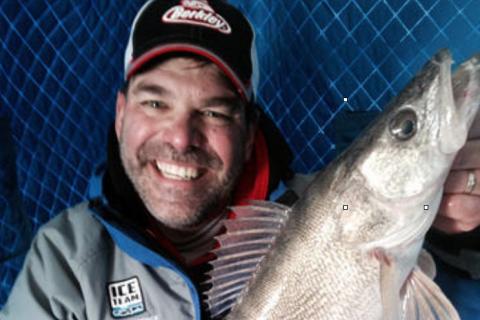
A trick I have used with some success when dealing with more finicky “below the ice” walleyes this time of year is to play a game of cat-and-mouse with them. Say you are watching a fish on your fish finder but the fish doesn’t bite your offering immediately. That’s a good time to begin raising the bait up aggressively – often several feet – jiggle it and then raise it up some more (often having to reel in line).
It is important to watch your depth finder to see how far and how aggressively you can try to  pull the fish up and get it to bite. But this time of year pulling a walleye up 10 to 15 feet before it bites is not uncommon. It’s a trick to keep in mind that can often pay off big.
pull the fish up and get it to bite. But this time of year pulling a walleye up 10 to 15 feet before it bites is not uncommon. It’s a trick to keep in mind that can often pay off big.
So what are the best baits to use for these “aggressive” actions? One of the most productive is what we call Glide Baits, like Moonshine Lure’s Shiver Minnow, This “minnow-like” jigging lure has a dramatic side-to-side darting movement when jigged, giving you great horizontal coverage of the area under your ice hole.
The Shiver Minnow comes in a variety of sizes and in an array of awesome “glow” color patterns that last a long time and are deadly during the prime-times of dusk and dawn when walleyes tend to feed the heaviest.
Jigging Spoons
Jigging spoons are another great choice for this time of year. You want to choose spoons that offer lots of flash, but also have a distinct and enticing flutter on the drop. Top choices here would include the Clam Blade Spoon, the ever-popular Swedish Pimple and Acme’s Sidewinder and Kastmaster spoons. Another lure we are anxious to put to use this season is Clam’s new Time Bomb Spoon. Each of these have their own distinct shape and therefore feature different flash and flutter patterns. Trying a variety of lures will help you to dial-in the right one to get the most bites.

great choice for ice fishing.
A big key to success with any ice jigging spoon is to know where your lure is in relation to the bottom at all times. Let out enough line to position your lure about six inches off the bottom when your rod tip is at a set position above the ice. Then, when you stroke the lure up and let it free-fall and flutter down, the spoon will stop just above the bottom, provided you return your rod tip to the pre-set position. Hold your rod still for just a second or so before imparting any more action to the lure. This moment as the spoon is at the bottom of the stoke and still slightly spinning, twisting and glinting is where it resembles a dying baitfish fighting off the final death throws, and it’s this moment most strikes will occur.
Add a Bit of Finesse Fishing to Sweeten the Deal
Now while Glide baits and Spoons are aggressive presentations and great at attracting walleyes from a distance, it can also be a good idea to incorporate a bit of finesse into your plan as well. We like to employ a Deadstick to the set-up, rigging a small jig tipped with a minnow on a rod we set in a second hole near our jigging hole. Set the jig so it sits about a foot off the bottom. Many times, you will draw fish in with the more aggressive lure, only to have it bite the less aggressive offering. On an LCD unit like the Lowrance Elite-5 Ice Machine’s we use, the jig will appear as a straight line on the screen. If that line all of a sudden gets wider, that indicates a fish has nosed up to the jig or is about ready to be your Next Bite.
- 37036 views

